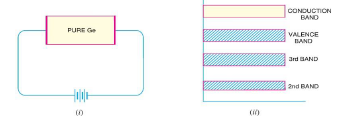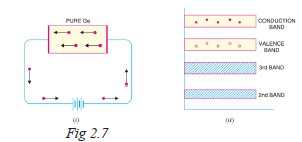- The electrical conductivity of a semiconductor changes appreciably with temperature variations. This is a very important point to keep in mind.
(i)
At absolute zero: At absolute zero temperature, all the electrons are tightly held by the semiconductor atoms. The inner orbit electrons are bound whereas the valence electrons are engaged in covalent bonding. At this temperature, the covalent bonds are very strong and there are no free electrons. Therefore, the semiconductor crystal behaves as a perfect insulator [See Fig. 2.6 (i)].
(ii) In terms of energy band description, the valence band is filled and there is a large energy gap between valence band and conduction band. Therefore, no valence electron can reach the conduction band to become free electron. It is due to the non-availability of free electrons that a semiconductor behaves as an insulator.
(iii)
Above absolute zero: When the temperature is raised, some of the covalent bonds in the semiconductor break due to the thermal energy supplied. The breaking of bonds sets those electrons free which are engaged in the formation of these bonds. The result is that a few free electrons exist in the semiconductor

- These free electrons can constitute a tiny electric current if potential difference is applied across the semiconductor crystal [See Fig. 2.7 (i)]. This shows that the resistance of a semiconductor decreases with the rise in temperature i.e. it has negative temperature coefficient of resistance. It may be added that at room temperature, current through a semiconductor is too small to be of any practical value.

- Fig. 2.7 (ii) shows the energy band diagram. As the temperature is raised, some of the valence electrons acquire sufficient energy to enter into the conduction band and thus become free electrons. Under the influence of electric field, these free electrons will constitute electric current. It may be noted that each time a valence electron enters into the conduction band, a hole is created in the valence band.
- Holes also contribute to current. In fact, hole current is the most significant concept in semiconductors.
Wilfykil answered the question on
August 13, 2019 at 12:37